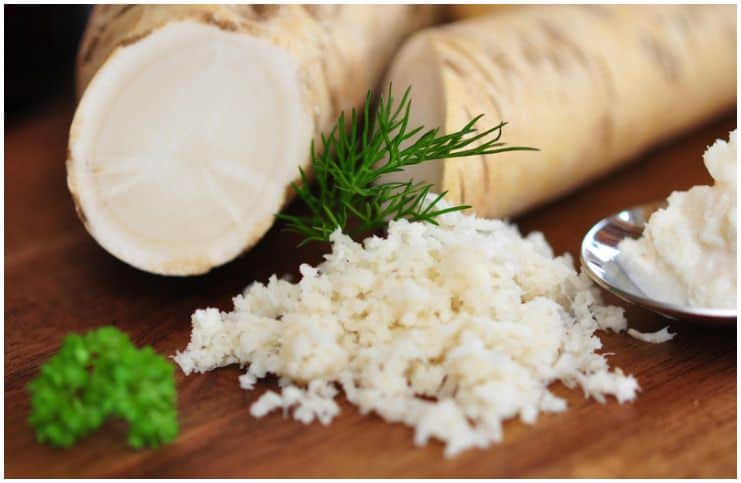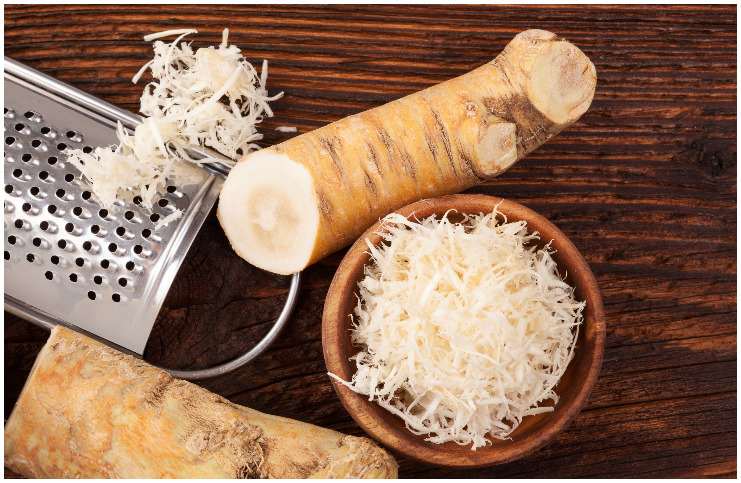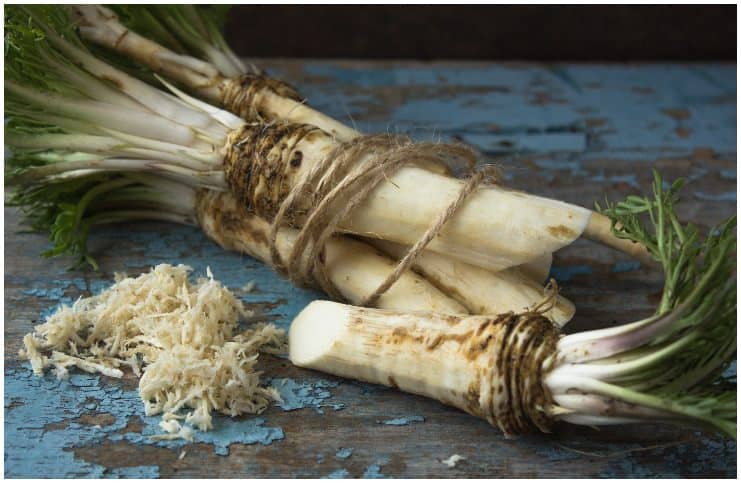Horseradish (botanical name – Armoracia rusticana) is a root vegetable that’s most usually consumed as a spice of the Brassicaceae family (which also includes radish, mustard, kale, broccoli, wasabi, brussels sprouts, and cabbage).
Native to the Mediterranean and Eastern regions of Europe and western Asia, it is currently also grown all over the U.S. and in other parts of Europe. Both leaves and roots were used as a medicine during the Middle Ages.
Nutrition facts
This vegetable is a good source of dietary fiber, vitamins, such as – thiamine (B1), niacin (B3), riboflavin (B2), pantothenic acid (B5), folate (B9), pyridoxine (B6), C, K, minerals which include – calcium, phosphorus, iron, copper, selenium, potassium, sodium, zinc, manganese, and magnesium, protein and omega 3 fatty acids. It also contains mustard oil and glucosinolates.
Health benefits of eating horseradish root
Weight loss
Part of slimming down involves a simple eating plan and physical exercise.
This vegetable is low in fat and calories (100g contains 0,7g of fat and has 48 kcal, plus, it has 3,3 g of dietary fiber). High-fiber foods are filling and can also make you feel full longer and curb overeating.
Skin health
Vitamin C is found at high levels in the epidermis and has an important role in collagen production, keeping your skin healthy (100g of this vegetable contains 28% vitamin C of the recommended daily intake).
Furthermore, increasing the quantity of vitamin C in the diet can contribute to a faster healing rate of the damaged skin.
In addition, vitamin C helps fend off the signs of aging because of its crucial role in the body’s collagen production. This root is also used as an ingredient in numerous beauty and cosmetics treatments.
Cleanses the liver

Glucosinolates are potent substances found only in plants belonging to the Brassicaceae family. This group also includes cauliflower, mustard, and broccoli. The antioxidant properties of glucosinolates are believed to increase cancer resistance in humans and helps the liver break down carcinogens.
In addition, this root is a natural diuretic. Diuretics increase the amount of urine you would normally excrete. Therefore, it’s so vital to add vegetables from the Brassicaceae family to your daily diet.
Cancer prevention
The active plant compounds – glucosinolates (by the way, this vegetable has ten times more glucosinolates than broccoli) prevent and stop cancer by encouraging cancer cells to commit suicide.
More importantly, glucosinolates also suppress genes that create new blood vessels, that support tumor spread and growth.
Additionally, the glucosinolates content in Armoracia rusticana can contribute to the elimination of free radicals, which can increase your risk of other serious health conditions.
Fetal development
Folate or vitamin B9 is essential for cell growth. Moreover, studies have shown that vitamin B9 helps prevent several birth defects (especially anencephaly and spina bifida).
All of these birth defects happen during the first month of pregnancy, hence, it is important for all women of childbearing age to have adequate levels of folate in the diet.
Folate also promotes healthy neural tube formation and adequate birth weight. Pregnant women should get 600 mcg of vitamin B9 daily. 100g of this root contains 57 mcg folate.
Note – supplementation with folic acid (the synthetic form of folate) is linked to many adverse effects, including an increase in the risk of colorectal cancer.
Boosts immunity
Selenium, discovered as an element in 1817, is a trace mineral that acts as a powerful antioxidant to prevent the formation of free radicals.
Selenium also boosts the immune system function and can also be an essential nutrient in counteracting the development of viruses. More importantly, this mineral is vital for both female and male reproductive health and counteracts the side effects of heavy metals.
Low selenium levels are strongly associated with an increased risk of heart disease, Crohn’s disease, and cancer. 100g of A. rusticana contains 5% selenium of the recommended daily intake.
How to eat
The root is usually not cooked and can be used like garlic, making a nice addition to sauces. The leaves are commonly added to fermented pickles to keep them crunchy. Furthermore, the dried root is available on the market.
Selection and storage
Choose firm roots with cut ends that look fresh and avoid if the root is dry and soft.
You can store fresh horseradish in the fridge for 7 to 10 days. Store the root in the refrigerator for up to six months.
Side effects of horseradish root
People with digestive system problems should avoid this vegetable as it may make them worse.
References https://www.ncbi.nlm.nih.gov/pmc/articles/PMC3673383/ https://www.ncbi.nlm.nih.gov/pmc/articles/PMC2737735/ http://ajcn.nutrition.org/content/85/2/598S.full





